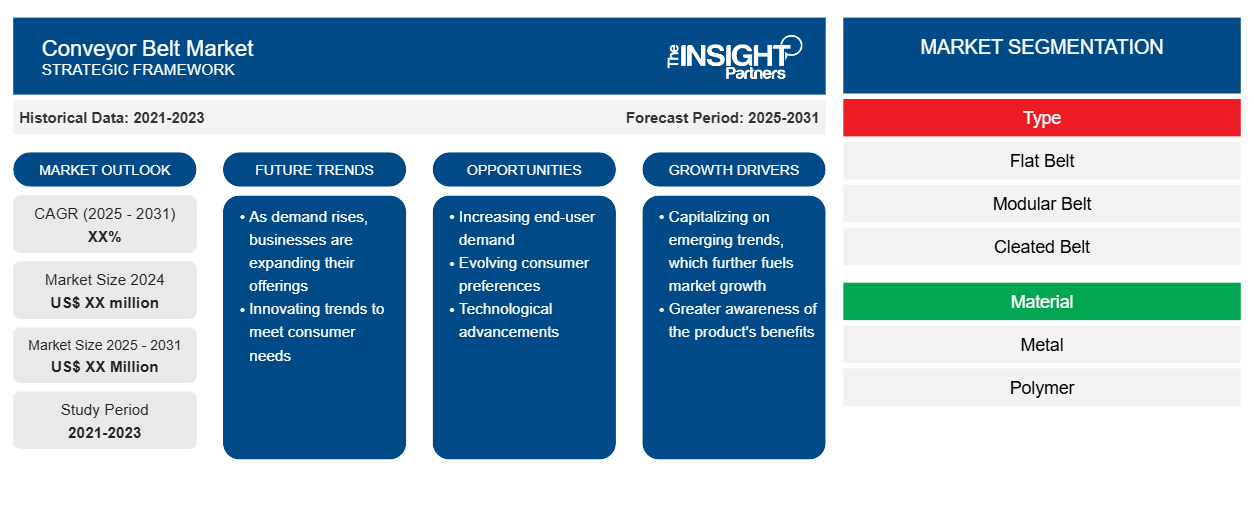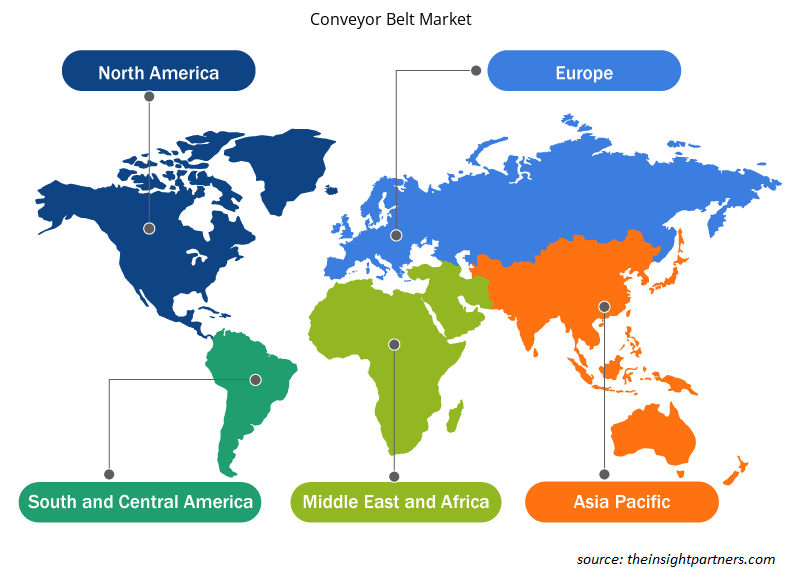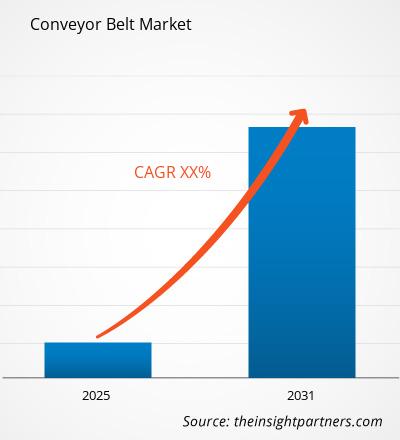预计到2031年,传送带市场规模将从2024年的54.8026亿美元增至78.0595亿美元。预计2025年至2031年期间,该市场的复合年增长率将达到5.3%。传送带系统与人工智能的融合有望在未来几年为市场带来新的趋势。
传送带市场分析
由于汽车、电商消费品、采矿和金属、食品和饮料、回收、农业以及航空航天和国防工业对工业和仓库自动化的需求不断增长,传送带市场正在大幅增长。其他关键驱动因素包括生产设施需求的增加、产品开发的增加以及全球机场的不断扩张。市场拥有充满活力的竞争格局。大陆集团、芬纳、阪东化学工业、普利司通公司和哈伯斯特股份公司是传送带市场的主要参与者。主要参与者和其他供应商之间的竞争非常激烈。大型公司获得额外竞争优势的因素包括广泛的分销网络、多样化的产品组合、多年的运营经验、持续的产品创新以及并购。
传送带市场概况
采矿业和制造业正在大力推广重型传送带,因为它们能够简化物料处理、降低人工成本并提高运营效率。相比之下,食品饮料加工、包装和物流行业则在全球范围内采用轻型传送带,因为它们的需求各不相同。这种动态催生了一个竞争激烈的细分市场,各公司为轻型应用行业提供解决方案。一些公司专注于重型应用。橡胶或合成材料等原材料价格的波动直接影响着供应商的利润率和定价策略。大型制造商会协商降低原材料价格并控制成本波动,而小型企业则需要通过专业化和增强服务来脱颖而出。由于对可持续和环保产品的关注,竞争环境发生了变化,制造商正在分配资源来开发环保型传送带材料和节能设计,以满足不断变化的客户需求和监管标准。
您可以免费定制任何报告,包括本报告的部分内容、国家级分析、Excel 数据包,以及为初创企业和大学提供优惠和折扣
传送带市场:战略洞察

- 获取此报告的顶级关键市场趋势。此免费样品将包括数据分析,从市场趋势到估计和预测。
传送带市场驱动因素和机遇
全球机场不断扩张
由于航空客运和货运活动的增加,全球机场基础设施正在扩大。2023 年 3 月,国际机场理事会 (ACI Europe) 宣布,2023 年 1 月欧洲机场网络的客运量与 2022 年 1 月相比增长了 69% 以上。2023 年 3 月,运输公司 Fraport 投资约 57 亿美元(40 亿欧元)扩建德国主要机场枢纽法兰克福国际机场。扩建工程预计将于 2026 年完成。根据这一扩建项目,预计空中交通量将从 2023 年的每小时 80 架次增加到 2026 年的 120 架次。各国政府正在推动对现有机场的投资。例如,美国联邦航空管理局宣布拨款 10 亿美元改善 99 个机场的基础设施。这笔资金是通过拜登总统 2023 年的两党基础设施法提供的。
随着机场规模的扩大,它们需要先进的传送带来管理更高的客流量,确保顺畅运行,减少延误,并提升整体出行体验。这种扩张需要自动化、高容量的传送系统,以便更高效地处理行李和货物。
仓库自动化程度激增
全球物流和仓储行业正经历着电子商务的蓬勃发展、制造业的蓬勃发展、消费增长以及整体产业的扩张。然而,复杂的供应链、低效的运营、不断增长的成本以及快速交付的需求,都给行业带来了挑战。该行业正在寻求仓库自动化来解决这些难题,并充分利用这一扩张机遇。采用自动化技术可以提高生产力、降低人工成本、减少错误、优化库存管理并确保成本效益,从而使仓库能够更高效地处理大量货物。全球仓库数量的增长源于电子商务领域需求的飙升、最后一英里配送以及消费者行为的变化。
仓库自动化和仓库数量的激增增加了对高效自动化物料处理系统的需求。随着企业寻求精简运营,传送带在提高速度、准确性和成本效益方面发挥着至关重要的作用。电子商务的兴起推动了对快速可靠的物流解决方案的需求。传送带使大型仓库内的货物运输更加顺畅,从而提高了运营效率。总而言之,预计仓库基础设施和自动化的持续扩张将为未来市场带来增长机会。
传送带市场报告细分分析
有助于得出传送带市场分析的关键部分是类型、材料类型和应用。
- 按类型划分,市场可分为平带式输送机、倾斜/下降式输送机、移动式输送机、带夹板输送机、模块化输送机、滚筒床式输送机等。2024年,平带式输送机占据了市场主导地位。
- 根据材料类型,市场分为金属、聚合物、橡胶、树脂和其他。2024年,橡胶领域占据市场主导地位。
- 根据应用,市场分为轻量级、中量级和重量级应用。2024年,中量级应用占据了市场主导地位。
- 按行业划分,市场分为采矿和金属、汽车、一般制造业、食品和饮料、发电、回收、石油和天然气、农业、航空航天和国防等。2024年,一般制造业占据了市场主导地位。
传送带市场份额(按地区)分析
传送带市场分为五大区域:北美、欧洲、亚太地区 (APAC)、中东和非洲 (MEA) 以及南美和中美 (SAM)。2024 年,亚太地区占据市场主导地位,其次是北美和欧洲。
欧洲的传送带市场细分为德国、法国、意大利、英国、俄罗斯和欧洲其他地区。该地区对先进制造能力和更高运营效率的需求日益增长。制药、汽车、食品饮料和电子行业正在采用传送系统来改进生产流程并优化资源管理。智能制造和工业4.0的推动正促使制造商实施更复杂的数据驱动解决方案,以实现实时监控、预测性维护和质量管理。智能制造和工业4.0通过集成物联网、人工智能和自动化来实现实时监控和自适应控制,从而推动了对传送带的需求。这种集成提高了效率,减少了停机时间,并简化了工厂的物料流。因此,各行各业正在采用先进的传送系统来支持高速生产。例如:
- 2024 年 11 月,Montech Conveyors Corp. 宣布推出其新的 SOLTB 带式输送机系列,旨在优化包装材料和燃料、电池和太阳能电池等能源转换器的工艺。
- 2023年3月,横滨宣布推出Hamaheat系列耐高温输送带“Hamaheat Super 80”。Hamaheat Super 80是基于Hamaheat系列中以耐高温性能而备受瞩目的高端产品“Hamaheat Super 100”而开发的中端产品,旨在根据使用条件优化性能,提供性价比更高的产品。
传送带市场区域洞察
Insight Partners 的分析师已详尽阐述了预测期内影响传送带市场的区域趋势和因素。本节还讨论了北美、欧洲、亚太地区、中东和非洲以及南美和中美的传送带市场细分和地理分布。

- 获取传送带市场的区域特定数据
传送带市场报告范围
| 报告属性 | 细节 |
|---|---|
| 2024年的市场规模 | 54.8026亿美元 |
| 2031年的市场规模 | 78.0595亿美元 |
| 全球复合年增长率(2025-2031) | 5.3% |
| 史料 | 2021-2023 |
| 预测期 | 2025-2031 |
| 涵盖的领域 | 按类型
|
| 覆盖地区和国家 | 北美
|
| 市场领导者和主要公司简介 |
|
传送带市场参与者密度:了解其对业务动态的影响
传送带市场正在快速增长,这得益于终端用户需求的不断增长,而这些需求又源于消费者偏好的不断变化、技术进步以及对产品优势的认知度不断提升等因素。随着需求的增长,企业不断扩展产品线,不断创新以满足消费者需求,并抓住新兴趋势,从而进一步推动市场增长。
市场参与者密度是指特定市场或行业内企业或公司的分布情况。它表明特定市场空间内竞争对手(市场参与者)的数量相对于其规模或总市值而言。
在传送带市场运营的主要公司有:
- 哈伯斯特公司
- 福尔波控股公司
- 森佩里特股份公司
- 阿什沃思兄弟公司
- 芬纳·邓禄普
- MacAljon公司
免责声明:以上列出的公司没有按照任何特定顺序排列。

- 获取传送带市场主要参与者的概述
传送带市场新闻和最新发展
传送带市场评估通过收集一手和二手资料进行定性和定量分析,包括重要的企业出版物、协会数据和数据库。传送带市场的主要发展趋势如下:
- 伯曼集团整合了原 FAM 在巴西、秘鲁和智利的业务,扩大了其在南美的业务版图。此前,集团于 2022 年收购了 FAM Minerals & Mining GmbH。原 FAM 业务现已更名为伯曼集团南美分公司,并已成为伯曼家族不可或缺的一部分,将为客户提供全系列的伯曼自动化物料搬运解决方案和服务。这一里程碑彰显了伯曼集团对南美地区客户的长期承诺,也代表了其在该地区的一项重大投资。(来源:伯曼集团,新闻稿,2024 年 6 月)
- 福尔波传动系统 (Forbo Movement Systems) 推出一款全新输送带。它非常适合窄带应用,以及输送巧克力棒或零食等无包装食品。这款全新 Transilon E 2/1 U0/U8 LG 蓝色 FDA 输送带(货号 904718)最初是为一家知名的管袋包装机原始设备制造商 (OEM) 开发的,现在可应用于小型输送机的刀口输送。刀口输送带的优势在于,在两条输送机之间输送时,输送带间隙非常小。因此,即使是非常小的产品也能非常轻柔地输送。(来源:福尔波传动系统,新闻稿,2025 年 2 月)
传送带市场报告覆盖范围和交付成果
《传送带市场规模和预测(2021-2031)》对以下领域进行了详细的市场分析:
- 传送带市场规模以及本范围涵盖的所有主要细分市场的全球、区域和国家层面的预测
- 传送带市场趋势以及市场动态,例如驱动因素、限制因素和关键机遇
- 详细的 PEST 和 SWOT 分析
- 传送带市场分析涵盖主要市场趋势、全球和区域框架、主要参与者、法规和最新市场发展
- 行业格局和竞争分析,包括市场集中度、热图分析、知名参与者以及传送带市场的最新发展
- 详细的公司简介
- 历史分析(2 年)、基准年、预测(7 年)及复合年增长率
- PEST和SWOT分析
- 市场规模、价值/数量 - 全球、区域、国家
- 行业和竞争格局
- Excel 数据集
近期报告
相关报告
客户评价
购买理由
- 明智的决策
- 了解市场动态
- 竞争分析
- 客户洞察
- 市场预测
- 风险规避
- 战略规划
- 投资论证
- 识别新兴市场
- 优化营销策略
- 提升运营效率
- 顺应监管趋势




















 获取免费样品 - 传送带市场
获取免费样品 - 传送带市场